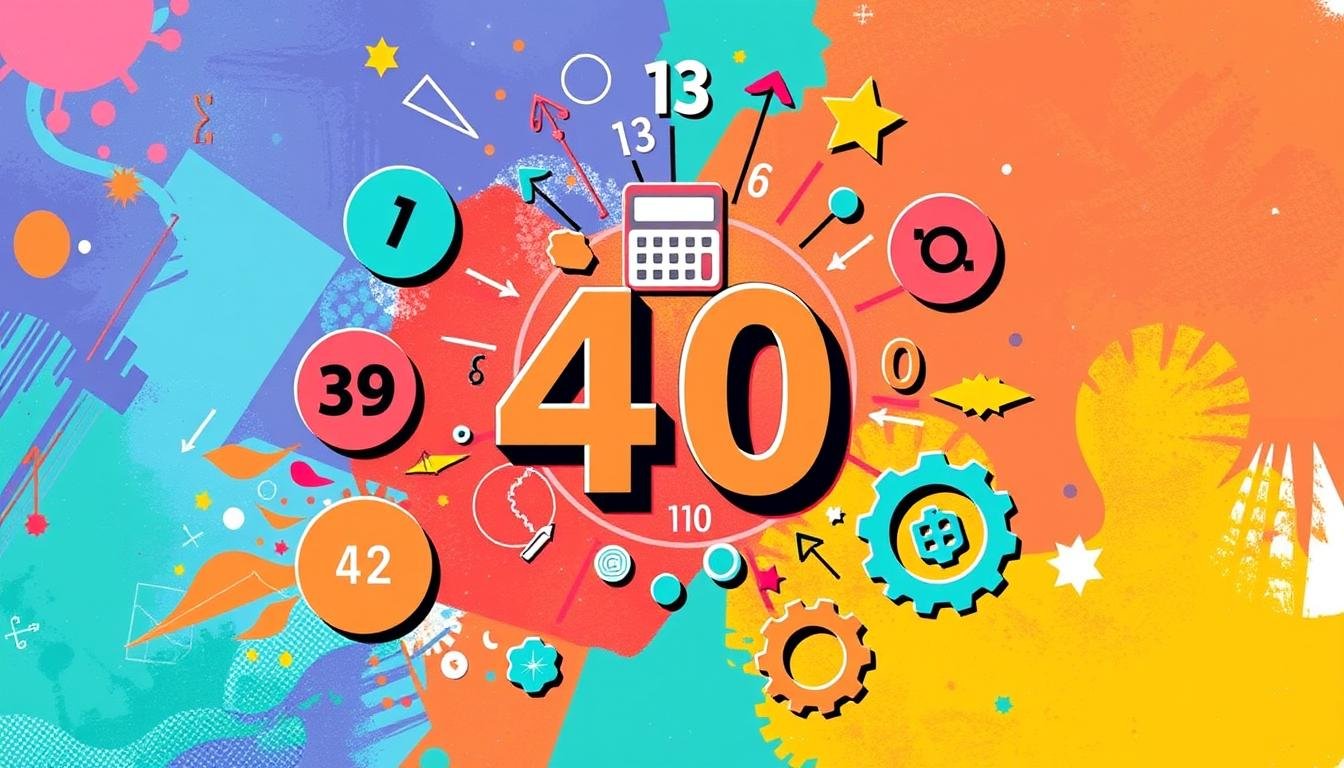A visually engaging mathematical diagram illustrating the factors 40, featuring vibrant colours and geometric shapes, with lines connecting the number 40 to its factors: 1, 2, 4, 5, 8, 10, 20, and 40. Incorporate elements such as circles or nodes for each factor and a central focal point representing the number 40, set against a clean, abstract background that enhances clarity and focuses on the mathematical relationships.
Factors are numbers that divide evenly into another number. They help us understand how numbers work together.
For 40, factors show interesting patterns. We’ll explore all possible aspects of 40.
We’ll also look at prime factorization. This will reveal what makes 40 special.
Finding factors of 40 requires careful thinking. We’ll use different methods to find them.
This guide will help students and math fans. You’ll learn how factors work in a fun way.
Get ready to unlock 40’s secrets. We’ll boost your math skills as we go.
Understanding Factors: Definition and Importance
Factors are key math concepts that help us grasp how numbers work. They divide numbers without leaving a remainder.
Factors break down numbers into essential parts. For example, the number 40 has several aspects.
Factors help solve complex problems in math and real life. They reveal number patterns and simplify math expressions.
Engineers and programmers use factors in their work. Factors make calculations more efficient and precise.
Learning factors help develop critical thinking skills. It gives a better grasp of math principles.
Prime Factorization of 40
Prime factorization breaks down a number into its most minor prime parts. For 40, this shows the unique mix of prime factors.
To find 40’s prime factors, we can use a factor tree. First, divide 40 by the smallest prime number.
Start by splitting 40 into 2 × 20. Then, break 20 down further: 2 × 2 × 10.
Keep going until you reach prime numbers. The final result is 2 × 2 × 2 × 5.
These prime factors are the 40s’ basic building blocks. They can’t be divided further without leaving a remainder.
Prime factorization helps solve tricky math problems. Students can use this skill for more complex math ideas.
Breaking 40 into 2³ × 5 shows how primes make more significant numbers. This method works for any whole number above zero.
Listing All Factors of 40
Factors divide evenly into 40 without leaving a remainder. Let’s find all the divisors of this number.
The factors of 40 are 1, 2, 4, 5, 8, 10, 20, and 40. These numbers divide 40 perfectly.
To find divisors, use a simple division method. Check which numbers divide 40 without any leftovers.
Small numbers like 1 and 2 are always factors. More significant numbers such as 20 and 40 are also factors.
Knowing 40 factors helps in math applications. Students can use these for problem-solving and understanding number relationships.
Every factor has a matching pair. When multiplied, they equal 40.
This symmetry makes finding factors fun. It’s an engaging math exercise for all.
Divisibility Rules Relevant to 40
This is a visually engaging illustration showcasing the concept of divisibility rules for the number 40. It includes representations of numbers 1 through 10, with visual indicators like arrows or lines connecting them to 40. Use vibrant colours and geometric shapes to symbolize different factors, such as circles for even numbers and stars for prime numbers, all radiating from a central depiction of 40. Incorporate elements like a calculator, gears, and mathematical symbols to enhance the theme of mathematics and divisibility, set against a dynamic, abstract background.
Divisibility rules help identify factors for complex numbers like 40. They allow quick determination without long calculations.
For 40, several key rules apply. A number is divisible by two if its last digit is even.
The last digit of 40 is 0, making it divisible by 2. This rule simplifies factor identification.
A number ending in 0 or 5 is divisible by 5. 40 perfectly meets this criterion.
Check the last two digits for divisibility by 4. If they’re divisible by 4, the whole number is, too.
The last two digits of 40 (40) are divisible by 4. This confirms another factor.
These rules show how number properties simplify factor identification. They help break down complex numbers into essential components.
Examples of Using Factors of 40
Factors of 40 can make math more valuable in real life. They help with planning activities and designing puzzles that need exact splitting.
Factors of 40 make math problem-solving fun. Teachers can use them to create cool group activities.
The factors of 40 are 1, 2, 4, 5, 8, 10, 20, and 40. These numbers help divide 40 items evenly into groups.
Architects use 40’s factors to design spaces. They help with making grid layouts and planning rooms.
Builders also need factors for exact measurements. Factors help them plan spaces and use materials wisely.
Computer coders use factors to make better programs. Factors help break down numbers for sorting and searching tasks.
Factors are helpful in many jobs. They help solve tricky problems in schools, buildings, and tech work.
Factor Pairs of 40
Factor pairs are unique number combos that multiply to make 40. Each pair has two factors that, when multiplied, equal 40.
We have several factor pairs for 40: 1 and 40, 2 and 20, 4 and 10, and 5 and 8.
These pairs show math’s symmetry. When you multiply each pair’s numbers, you always get 40.
Factor pairs help us understand number theory. They also teach us about arithmetic strategies.
Students can find these pairs through multiplication combos. For example, 2 × 20 and 4 × 10 both make 40.
Factor pairs are great teaching tools. They help develop mental math skills.
They improve multiplication understanding. They also lay the groundwork for complex math concepts.
Factor pairs offer valuable insights into math. They help with algebra problems and number patterns.
Common Mistakes When Finding Factors
Identifying factors can be tricky for students learning math. Factor errors often happen due to misconceptions about how numbers divide evenly.
One common mistake is forgetting to check both positive and negative factors. This can lead to incomplete solutions to factor problems.
Troubleshooting factor calculations requires a careful approach. Many students think only small numbers can be factors.
40 has multiple factor combinations that might not be obvious. Students often make mistakes by rushing through their work.
Careful step-by-step checking helps prevent wrong answers. List potential factors and check each one to ensure accurate division.
Some students mix up prime factors with regular factors. This can cause calculation errors in factor problems.
Breaking numbers into their most minor prime parts can help understand factor relationships. Visual tools like factor trees can reduce mistakes.
These methods help students track their work and spot errors early. By knowing these challenges, students can improve their factor skills.
This builds more substantial math confidence when working with numbers like 40. Practice and attention to detail are key to mastering factors.
Conclusion: Mastering the Factors of 40
Factors of 40 open up a fun world of math. By exploring divisibility and factor pairs, students develop essential thinking skills.
Factor mastery isn’t just about memorizing numbers. It’s about seeing patterns in math structures.
Learning about 40 factors shows how one number can teach a lot. Each step builds stronger math skills.
Students who learn these ideas can solve more complex math problems later.
Math skills grow when you practice and stay curious. The tricks you learn with 40 work for other numbers, too.
Try breaking down numbers to find their hidden parts. You’ll start to love math even more.
Factor mastery helps you think about math in new ways. Keep exploring and asking questions about numbers.
Math has many cool things to discover. You can learn them one factor at a time.
FAQ
What exactly are factors of 40?
Factors of 40 are whole numbers that are divided evenly into 40. These include 1, 2, 4, 5, 8, 10, 20, and 40.
How can I quickly find the factors of 40?
You can use systematic division or create a factor tree. Start by dividing 40 by whole numbers from 1 to 40.
Are prime factors different from regular factors?
Yes, prime factors are prime numbers that multiply to create 40. For 40, the prime factorization is 2³ × 5.
How many total factors does 40 have?
40 has 8 total factors: 1, 2, 4, 5, 8, 10, 20, and 40.
Can factors help me solve math problems?
Yes! Factors help with fractions, common denominators, and algebraic problems. They show number relationships and math patterns.
What makes 40 unique in terms of its factors?
40 has an even number of factors. It’s divisible by small prime numbers like 2 and 5.
Do divisibility rules apply to 40?
Yes, several divisibility rules work for 40. It’s divisible by 2, 4, and 5.
How are factor pairs related to the factors of 40?
Factor pairs are two numbers that multiply to give 40. For 40, the pairs are 1×40, 2×20, 4×10, and 5×8.
you may also read : Create Cool Names with Instagram Name Generator


